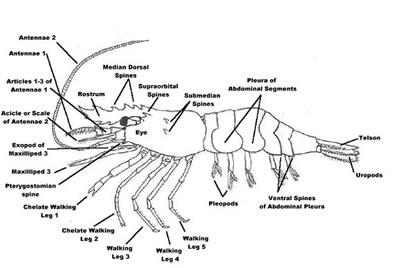

INFRORDER CARIDEA (SHRIMPS AND PRAWNS) OF
BRITISH COLUMBIA
Order Decapoda)
by
This group includes the local commercially important pandalid shrimp or prawns but also a large number of smaller and less known species. These smaller species are critical components of shallow water ecosystems, being a major prey item for fish, birds, as well as many invertebrate predators. Caridean shrimp are distinct in having the pleura (these are the overlapping rounded 'flaps' that extend downward from the abdominal segments) of abdominal segment 2 partially cover the pleura of abdominal segment 1 and 3. This is a large infraorder with over 90 species in BC with over half being shallow water and relatively common.

Shrimp morphology, illustration by Aaron Baldwin
The family Pandalidae contains species which grow large enough to be commercially harvested. The spot prawn, Pandalus platyceros, is our largest species, sometimes reaching 25 cm in total length! Because of their commercial importance pandalids have been extensively studied and we know more about them than we do about other shrimp species in the north Pacific. Pandalids, like many shrimp, are protandric hermaphrodites which means they begin as males then change into females with age. Because of this the commercial harvest is nearly exclusively female. Most species are male for the first 1-2 years then females for the remainder of their lives. Lifespan varies from 2 to 4 years. Some individuals change to female before becoming a sexually mature male and are called 'early maturing females'. It is not known what influences the 'decision' to skip the functional male portion of their life cycle. Most pandalids are active predators, feeding on smaller crustaceans and other invertebrates.
The families Oplophoridae and Pasiphaeidae are unusual in being completely pelagic, spending their entire lives in the water column. They are sometimes very deep, 1000 meters or more and suspension feed on 'marine snow', the detrital remains of surface plankton that rains down from above. Many of these shrimp migrate to near the surface at night, returning to depth during the day. The only commonly encountered member of this group is the glass shrimp Pasiphaea pacifica which is fairly common in plankton tows.
The family Hippolytidae is our most diverse family, with nearly 50 species in the northeastern Pacific. All are too small to really be of commercial interest although one species, Heptacarpus brevirostris, is reported to have supported a commercial fishery in San Francisco Bay during the 19th Century. I did see one very large species, Lebbeus groenlandicus, mixed in with smaller pandalids being sold off of a commercial shrimp boat in Juneau, Alaska. Very little is known about these shrimp, but it is likely that some of them are very important ecologically and may be an important part of the animal biomass in eelgrass and kelp habitats. In tropical waters the colorful and lively cleaner and peppermint shrimps (genus Lysmata) are a valuable part of the salt water aquarium trade.
The Crangonidae or sand shrimps are usually very common in shallow water habitats. Members of the genus Crangon, like the common name implies, are usually buried in sand. Their color mimics their habitat as to make them nearly invisible when not moving. Members of this family are unusual in having their first pair of walking legs subchelate (somewhat similar to a mantis forelimb) rather than bearing true claws. There is also a tendency in this family to have one or more pairs of the walking legs (usually 2 and three) greatly reduced or even absent (in the bizarre Paracrangon echinata the second walking leg is absent altogether). One species, the sculptured shrimp Sclerocrangon boreas, has greatly attenuated larval stages so that the young hatch as miniature versions of the adults and even cling to the mother for awhile after hatching.
The last family of shrimp found in BC are the Alpheidae. This fascinating family includes the well known pistol shrimps found in coral reefs. Their name stems from the fact that they produce a loud pop by snapping their claws shut. The claw closes at 20 meters per second. The tremendous force generated creates a cavitation bubble which moves at about 100 km/hr! Our species do not have this amazing trait, but are really no less interesting. The two species found in BC, members of the genus Betaeus, are associated with other invertebrates. One, Betaeus setosus, lives in male/female pairs under and around the thick-clawed porcelain crab Pachycheles rudis. The other species, Betaeus harrimani, lives in the burrows of the blue mud shrimp Upogebia pugettensis. They can be easily collected using a yabby pump, a device that uses a plunger to forcibly suck water out of burrows.
Please cite these pages as:
Author, date, page title. In: Klinkenberg, Brian. (Editor) 2021. E-Fauna BC: Electronic Atlas of the Fauna of British Columbia [www.efauna.bc.ca]. Lab for Advanced Spatial Analysis, Department of Geography, University of British Columbia, Vancouver. [Date Accessed]
© Copyright 2021 E-Fauna BC.